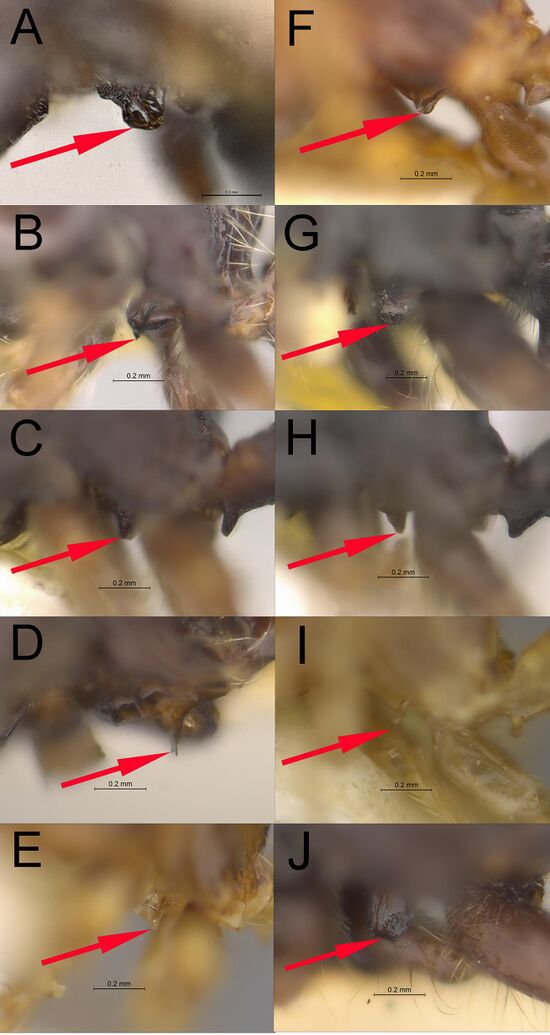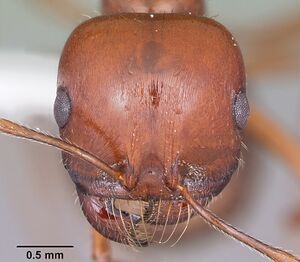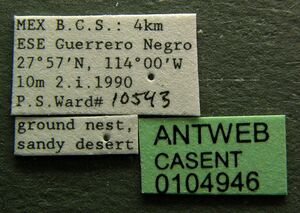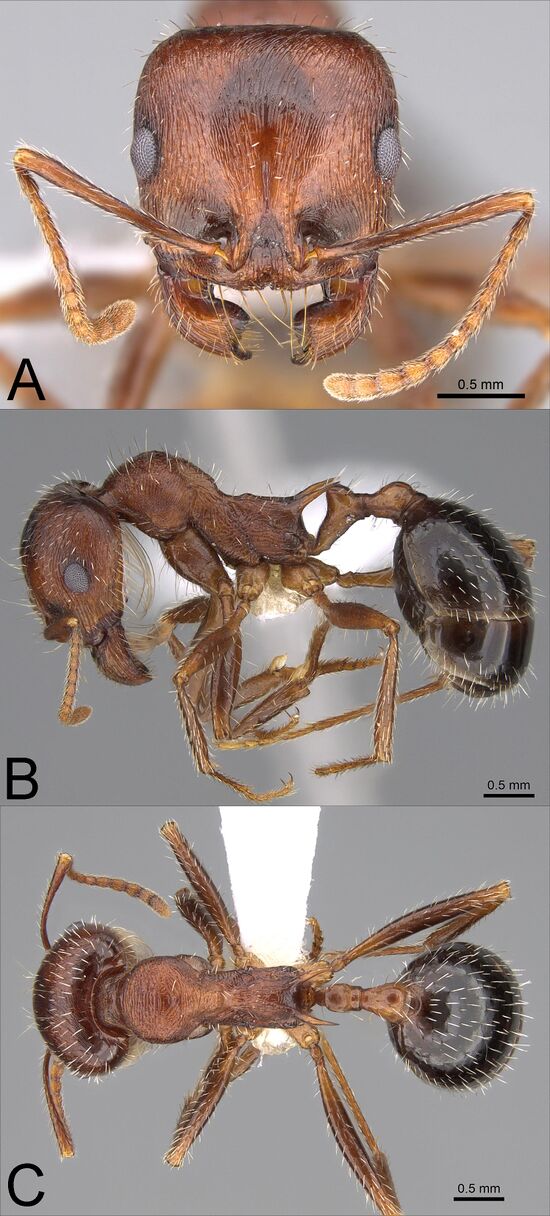Veromessor julianus
| Veromessor julianus | |
|---|---|

| |
| Scientific classification | |
| Kingdom: | Animalia |
| Phylum: | Arthropoda |
| Class: | Insecta |
| Order: | Hymenoptera |
| Family: | Formicidae |
| Subfamily: | Myrmicinae |
| Tribe: | Stenammini |
| Genus: | Veromessor |
| Species: | V. julianus |
| Binomial name | |
| Veromessor julianus (Pergande, 1894) | |
| Synonyms | |
| |
Veromessor julianus is a hot desert species that is endemic to the Baja California peninsula of Mexico at elevations from 0–625 m (see Johnson, 2000a; Johnson & Ward, 2002). It is most common in sandy soils but it also occurs on rocky hillsides and bajadas (Johnson et al., 2022). It uses column foraging to guide workers leaving and returning to the nest, as explained in the biology sections of Veromessor pergandei and Veromessor andrei.
Photo Gallery
Identification
Worker
This species is uniquely characterized by the following combination of features (Johnson et al., 2022):
- Head and gaster light to dark brownish-orange to dark brown; mesosoma lighter orangish-brown or head, mesosoma, petiole, postpetiole dark ferruginous orange; gaster dark brown to blackish
- Medial lobe of clypeus with 2–3 moderately coarse longitudinal rugae on either side of medial groove, medial lobe not thick and protuberant in profile, not elevated above lateral lobes in frontal view
- Mandibles with 8 teeth
- Dorsal base of scape weakly flattened, weakly widened; maximum basal width of scape distinctly less than maximum preapical width
- MOD usually much less than OMD, OI < 25.0
- Cephalic dorsum with fine, closely spaced, wavy, longitudinal rugae; medial rugae diverging toward posterior corners; cephalic interrugae weakly to moderately punctulate, moderately shining,
- Psammophore well developed; ventral surface of head capsule with many long J-shaped hairs arranged in a distinct row around the outer margin of the ventral region of the head capsule
- Dorsum of pronotum with mostly transverse, weakly to strongly irregular rugae, rugae often with lateral branches and/or becoming rugoreticulate posterad; sides of pronotum variable: with irregular vertical and/or longitudinal rugae or rugae mostly confined to anterior one-half, posterior one-half strongly granulate or strongly granulate over entire surface, interrugae and granulate surfaces dull; mesonotum with irregular longitudinal rugae, rugae sometimes with short lateral branches, interrugae weakly coriarious, moderately shining to strongly granulate, dull or entire surface strongly granulate, dull; mesopleura variable: strongly granulate between irregular, longitudinal and/or oblique rugae, rugae often with short lateral branches on dorsal one-half, irregular longitudinal rugae on ventral one-half or rugae faint to mostly lacking, entire surface strongly granulate, dull
- Propodeal spines elongate, slender, acuminate; spines straight in profile, weakly curved inward in dorsal view; length > 2.0× the distance between their bases and length > 1.0× MOD; infraspinal facet weakly coriarious to weakly rugose, moderately shining; propodeal declivity smooth and shining
- Metasternal process large, about twice as long as high, apex more or less flat, translucent in profile (Figures 20–22).
Queen
This caste is diagnosed by the following combination of features (Johnson et al., 2022):
- Color variable: mostly concolorous medium to dark brown to brownish-black, legs and gaster usually orangish-brown or mostly concolorous ferrginous orange except for brownish katepisternum and mesoscutum (mesoscutum sometimes partly orangish), gastral terga with transverse blackish band along posterior margins
- Medial lobe of clypeus with two to three submedial and sublateral, longitudinal rugae
- Mandibles with 8 teeth
- Ddorsal base of scape weakly flattened; maximum basal width of scape less than maximum preapical width
- OMD distinctly less than MOD
- Cephalic dorsum shining between fine, longitudinal rugae, medial rugae continuing to posterior margin or medial rugae diverging toward posterior margin with fine, transverse to arcuate rugae along posterior margin; longitudinal rugae above and below eyes
- Psammophore well developed
- Sides of pronotum weakly to moderately punctulate between mostly longitudinal rugae; mesoscutum and mesoscutellum smooth and shining with scattered piligerous punctures, mesocutum often with faint longitudinal rugae posterad, mesoscutellum with faint rugae along anterior and/or lateral margins; anepisternum weakly to moderately punctulate, weakly shining, between fine, longitudinal rugae; katepisternum shinier, rugae weaker, rugae sometimes absent along anteroventral margin; sides of propodeum moderately punctate, weakly shining between coarser longitudinal and oblique rugae
- Propodeal spines elongate, acuminate, weakly recurved in profile, length greater than width at base and less than the distance between their bases; infraspinal facet and posterior declivity weakly to moderately coriarious, weakly shining to shining
- Metasternal process large, about twice as long as high, apex more or less flat, translucent (Figures 23–24)
Male
This caste is diagnosed by the following combination of features (Johnson et al., 2022):
- Blackish brown, gaster and appendages brown
- Clypeus weakly convex in profile, anteromedial margin of medial lobe concave with a small, narrow, medial excision
- Mandibles with 2, rarely 3, small triangular denticles or teeth basad of preapical tooth
- Anterior ocellus above level of top of eyes
- Anepisternum with wavy longitudinal rugae or rugae restricted to dorsad portion, interrugae weakly to moderately coriarious, dull to weakly shining, areas lacking rugae usually lineopunctate-granulate; katepisternum shinier, lacking obvious rugae, weakly to moderately coriarious with ventral margin usually less coriarious and shinier than rest of katepisternum
- Propodeum contiguously punctate, with scattered short, irregular, fine, oblique rugae; teeth or spines absent
- Metasternal process about twice as long as tall, apex mostly flat with anterior and posterior corners broadly rounded
- Subpetiolar process absent to low and obtuse (Figures 1D, 25)
 Johnson et al., 2022, Fig. 1. Photographs of the metasternal process on males of Veromessor: (A) V. andrei (CASENT4010823), (B) V. chamberlini (UCRC_ENT00500152), (C) V. chicoensis (CASENT0869853), (D) V. julianus (LACMENT359792), (E) V. lariversi (CASENT0761204), (F) V. lobognathus (LACMENT363986), (G) V. pergandei (CASENT0869850), (H) V. pseudolariversi (CASENT0869851), (I) V. smithi (LACMENT364071), and (J) V. stoddardi (LACMENT364102). Photographs by Robert Johnson from www.AntWeb.org.
Johnson et al., 2022, Fig. 1. Photographs of the metasternal process on males of Veromessor: (A) V. andrei (CASENT4010823), (B) V. chamberlini (UCRC_ENT00500152), (C) V. chicoensis (CASENT0869853), (D) V. julianus (LACMENT359792), (E) V. lariversi (CASENT0761204), (F) V. lobognathus (LACMENT363986), (G) V. pergandei (CASENT0869850), (H) V. pseudolariversi (CASENT0869851), (I) V. smithi (LACMENT364071), and (J) V. stoddardi (LACMENT364102). Photographs by Robert Johnson from www.AntWeb.org.
Identification Notes
Veromessor pergandei and Veromessor stoddardi are the only congeners that might be sympatric with V. julianus. Veromessor julianus cannot be confused with either species, and it is diagnosed by: (1) well developed psammophore, (2) long propodeal spines (> 2× longer than distance between their bases), and (3) metasternal process about twice as long as high, apex more or less flat, translucent in profile. This species is recognized in the field based on their large colonies (> 40,000 workers) that forage in long columns from near dusk and into the night (Creighton, 1953; Johnson, 2000a, 2000b). Veromessor julianus may be sympatric with Veromessor andrei near Bahía San Quintin, but the former species is easily distinguished by its well developed psammophore; the psammophore is poorly developed in V. andrei. (Johnson et al., 2022)
 Johnson et al., 2022, Fig. 53. Eye area (mm2) (A), facet number (B), and mean facet diameter (μm) (C) for pale and dark colored species of Veromessor. Two species are pale (V. lariversi, V. pseudolariversi—open symbols and regular font), while the other eight species are dark (filled symbols and bold font). For each species, number of workers examined and number of colonies they were derived from is given in parentheses. Significant differences (P < 0.05) among species are denoted after each species name by the letters a–g: a > b > c > d > e > f > g; the three sets of letters for each species correspond to panels A, B, and C, respectively. Groupings are based on univariate F tests within MANCOVA followed by pairwise comparisons using a least significant differences test (see also Johnson & Rutowki, 2022).
Johnson et al., 2022, Fig. 53. Eye area (mm2) (A), facet number (B), and mean facet diameter (μm) (C) for pale and dark colored species of Veromessor. Two species are pale (V. lariversi, V. pseudolariversi—open symbols and regular font), while the other eight species are dark (filled symbols and bold font). For each species, number of workers examined and number of colonies they were derived from is given in parentheses. Significant differences (P < 0.05) among species are denoted after each species name by the letters a–g: a > b > c > d > e > f > g; the three sets of letters for each species correspond to panels A, B, and C, respectively. Groupings are based on univariate F tests within MANCOVA followed by pairwise comparisons using a least significant differences test (see also Johnson & Rutowki, 2022).
Keys including this Species
Distribution
Veromessor julianus is a hot desert species that is endemic to the Baja California peninsula of Mexico at elevations from 0–625 m (see Johnson, 2000a; Johnson & Ward, 2002). It is most common in sandy soils but it also occurs on rocky hillsides and bajadas. Veromessor julianus has a parapatric distribution with Veromessor pergandei, with the former species occurring in slightly more mesic microhabitats, i.e., in wetter soils and/or at higher elevations (Johnson, 2000a; R.A. Johnson, pers. obs.). This species occurs in the Baja California desert, Gulf of California xeric scrub, San Lucan xeric scrub, and Sierra de la Laguna dry forests ecoregions, as defined by Olson et al. (2001) (Figure 27A). (Johnson et al., 2022)
Latitudinal Distribution Pattern
Latitudinal Range: 31° to 22.6°.
| North Temperate |
North Subtropical |
Tropical | South Subtropical |
South Temperate |
- Source: AntMaps
Distribution based on Regional Taxon Lists
Neotropical Region: Mexico (type locality).
Distribution based on AntMaps
Distribution based on AntWeb specimens
Check data from AntWeb
Countries Occupied
| Number of countries occupied by this species based on AntWiki Regional Taxon Lists. In general, fewer countries occupied indicates a narrower range, while more countries indicates a more widespread species. |

|
Estimated Abundance
| Relative abundance based on number of AntMaps records per species (this species within the purple bar). Fewer records (to the left) indicates a less abundant/encountered species while more records (to the right) indicates more abundant/encountered species. |

|
Biology
The following notes are provided by Johnson et al. (2022).
Nests of V. julianus occur in open sites. Colonies of V. julianus have not been censused, but observations indicate that they contain tens of thousands of workers. Nests consist of a small tumulus lacking chaff to a large disc surrounded by chaff; nests sometimes have multiple entrances (Creighton, 1953; R.A. Johnson, pers. obs.). Workers of V. julianus forage in columns with workers fanning out to forage at the distal end of the column; workers clear a narrow trail through vegetation when necessary (Creighton, 1953; Johnson, 2000b). During winter and spring, foraging columns of V. julianus form prior to dusk, and foraging continues into the night with workers returning early the next morning (Johnson, 2000a), and it appears to forage during the day in at least some parts of its range (Creighton, 1953). Workers are weakly polymorphic.
Gland chemistry has not been examined in V. julianus. Like other large-colony congeners, workers of V. julianus have a large pygidial gland reservoir with a textured tergal cuticle (Hölldobler et al., 2013).
Mating flights of V. julianus occur in February–March with few sexuals being released over 1–2 or more weeks. Flights occur during early morning (8:30–10:00 MST) at temperatures from 16–23° C, and occur during mild breezes or overcast skies, but they were precluded by light rain or moderate breezes (Johnson, 2000a). Mating appears to occur in the air.
Queens are haplometrotic (Johnson, 2000a). Dry mass of alate queens averages 11.1 + 0.4 mg. Alate queens contain an average of 47.4 + 1.9 (n = 5) ovarioles, and mated queens contain an average of 1.225 + 0.02 (n = 2) million sperm. Dry mass for virgin males averages 1.9 + 0.2 mg, and they contain an average of 4.4 + 0.17 (n = 3) million sperm (R.A. Johnson, unpub. data). Queens have a relatively low heat tolerance compared to other desert ants with most queens dying in hydrated conditions at 42° C and all at 43° C over a 2 hour period (Johnson, 2000a). Ventilation patterns and metabolic rate of workers and alate queens are discussed in Lighton and Berrigan (1995).
Flight Period
| X | X | ||||||||||
| Jan | Feb | Mar | Apr | May | Jun | Jul | Aug | Sep | Oct | Nov | Dec |
Source: Johnson et al., 2022.
- Check details at Worldwide Ant Nuptial Flights Data, AntNupTracker and AntKeeping.
 Explore: Show all Flight Month data or Search these data. See also a list of all data tables or learn how data is managed.
Explore: Show all Flight Month data or Search these data. See also a list of all data tables or learn how data is managed.
Castes
Images from AntWeb
   
| |
| Worker. Specimen code casent0104946. Photographer April Nobile, uploaded by California Academy of Sciences. | Owned by UCDC, Davis, CA, USA. |
   
| |
| Syntype of Aphaenogaster juliana. Worker. Specimen code castype00619. Photographer April Nobile, uploaded by California Academy of Sciences. | Owned by CAS, San Francisco, CA, USA. |
Nomenclature
The following information is derived from Barry Bolton's Online Catalogue of the Ants of the World.
- julianus. Aphaenogaster juliana Pergande, 1894: 164 (w.) MEXICO (Baja California).
- Type-material: 7 syntype workers.
- Type-locality: Mexico: Baja California, San Julio (G. Eisen).
- [Note: Wheeler, W.M. & Creighton, 1934: 370, refer to “types taken by Pergande”, but in the introduction to Pergande, 1894: 161, Gustav Eisen is named as the collector.]
- Type-depository: USNM.
- Combination in Stenamma (Messor): Emery, 1895c: 308;
- combination in Aphaenogaster (Messor): Forel, 1899c: 59;
- combination in Novomessor: Emery, 1915d: 73;
- combination in Novomessor (Veromessor): Forel, 1917: 235; Emery, 1921f: 67;
- combination in Messor: Wheeler, W.M. 1910g: 565; Bolton, 1982: 341 (in text);
- combination in Veromessor: Wheeler, W.M. & Creighton, 1934: 368; Ward, et al. 2015: 73.
- Status as species: Emery, 1895c: 308; Forel, 1899c: 59; Wheeler, W.M. 1910g: 565; Emery, 1915d: 73; Emery, 1921f: 67; Wheeler, W.M. & Creighton, 1934: 368 (redescription); Enzmann, J. 1947b: 152 (in key); Bolton, 1995b: 254.
- Distribution: Mexico.
- clarior. Veromessor julianus subsp. clarior Wheeler, W.M. & Creighton, 1934: 370 (w.) MEXICO (Baja California).
- Type-material: syntype workers (number not stated).
- Type-locality: Mexico: Baja California, Commondu (H.C. Millender).
- Type-depository: MCZC.
- Combination in Messor: Bolton, 1995b: 253.
- Subspecies of julianus: Enzmann, J. 1947b: 152 (in key); Bolton, 1995b: 253.
- Junior synonym of julianus: Johnson et al., 2022: 40.
- Distribution: Mexico.
- manni. Veromessor julianus subsp. manni Wheeler, W.M. & Creighton, 1934: 371 (w.) MEXICO (Baja California).
- Type-material: 5 syntype workers.
- Type-locality: Mexico: Baja California, Purissima (W.M. Mann).
- Type-depository: MCZC.
- Combination in Messor: Bolton, 1995b: 255.
- Subspecies of julianus: Bolton, 1995b: 255.
- Junior synonym of julianus: Johnson et al., 2022: 40.
- Distribution: Mexico.
Type Material
Aphaenogaster juliana
- Lectotype worker (designated by Johnson et al., 2022: 40) from San Julio, Baja California Sur (as Lower California), Mexico, no date (Dr. Gustav Eisen) [CASTYPE00619] [CASC].
- Paralectotypes: 5 workers [USNM], #4479, MEXICO, Lower California (=Baja California Sur): San Julio, no date (Dr. Gustav Eisen).
Veromessor julianus clarior
- Lectotype worker (designated by Johnson et al., 2022: 40) from San José de Comondú, Baja California Sur, Mexico, February 1923 (H.C. Millender) [USNMENT00529096] [USNM].
- Paralectotypes: 3 workers [LACM], 5 workers [USNM], MEXICO, Baja California Sur: San José de Comondú, February 1923 (H.C. Millender).
Veromessor julianus manni
- Lectotype worker (designated by Johnson et al., 2022: 40) from Las Parras, Baja California Sur, Mexico, no date (Dr. W.M. Mann) [CASENT0922841] [USNM].
- Paralectotype: 1 worker [USNM], MEXICO, Baja California Sur: Las Parras, no date (Dr. W.M. Mann).
Wheeler and Creighton (1934) misspelled the type locality for V. julianus subsp. clarior as Commondu, Lower California; the correct spelling is Comondú (= San José de Comondú), which is in Baja California Sur, Mexico. For V. julianus subsp. manni, Wheeler and Creighton (1934) gave type locality as “Purissima, Lower California”, collected by W.M. Mann. However, no type material was located from “Purissima” and we believe their original citation to be spurious. We did locate two workers collected at Las Parras, Baja California, by W.M. Mann [USNM] with the additional label “not a syntype?, M. R. Smith”. We believe that Las Parras is the correct type locality, such that both of these workers are syntypes of V. julianus subsp. manni. We designated the bottom worker as a lectotype and placed such a label on the pin. Las Parras is a few miles west of Loreto. (Johnson et al., 2022)
Unless otherwise noted the text for the remainder of this section is reported from the publication that includes the original description.
Description
Worker
Wheeler and Creighton (1934) – Length 5-8 mm.
Head in the largest workers sub quadrate, the length from the flat occipital border to the anterior margin of the clypeus very slightly exceeding the greatest width. Head widest just behind the eyes, the width slightly decreasing from that point to the insertion of the mandibles, sides straight or very slightly convex. In the smaller workers the head is somewhat more narrow, widest at the eyes, with the sides feebly convex and the occipital angles more broadly rounded, which gives the occipital border a slightly convex appearance. Clypeus short, scarcely projecting, the anterior edge with an irregular median impression, the median lobe not clearly marked off, the entire middle portion of the clypeus longitudinally striate. Frontal carinae narrow and rather short, feebly divergent in front, their lateral margins only moderately divergent behind and fusing with the head at a point on a level with the frontal area; the latter moderately depressed, and subopaque. Mandibles powerful, their exterior margin strongly and evenly curved; teeth poorly developed, the apical two much rounded and forming a terminal lobe at the junction of the outer and masticatory margins, the remainder of the masticatory margin serrate rather than toothed. Eyes oval, moderately convex, surrounded by a shallow and narrow groove. Antennal scapes straight and slender, the tips not noticeably swollen, the entire scape gradually increasing in diameter from base to apex. In repose the scape surpasses the occipital border by a distance slightly in excess of its greatest thickness. Funicular joints all notably broader than long, joints 2-6 of approximately the same diameter, the remaining joints increasing in thickness and forming a poorly developed terminal club.
Promesonotum seen from above subpentagonal, with the anterior border strongly convex, the two lateral and posterior borders more nearly straight. Promesonotal suture obsolete. Epinotum from above notably narrower than the pronotum, rectangular in outline, the sides not constricted at the mesoepinotal suture. Spines strongly divergent, straight, the apical two-thirds rather thin, the basal third decidedly thickened; length from base to apex slightly less than the distance between their tips. Seen in profile, the dorsum of the pronotum is feebly convex, that of the mesonotum virtually straight and sharply sloping, the epinotum much depressed, with straight basal and declivous faces which meet at a sharp angle. Declivous face of the epinotum approximately two-thirds as long as the basal face, the spines at their junction only slightly elevated, forming an angle of about twenty degrees with the plane of the basal face. Mesoepinotal suture not impressed.
Petiole in profile with a long, thick, tapering anterior peduncle which has neither ventral tooth nor lamella. Anterior face of the node sloping forward to form a broad angle with the dorsum of the peduncle. Posterior face of the node strongly convex, meeting the anterior face in a sharp angle at the summit of the node. Posterior peduncle very short. Postpetiole in profile with a rather long and narrow anterior peduncle, the node low, feebly convex above, its posterior face not constricted into a posterior peduncle but broadly applied to the first gastric segment. Seen from above, the petiole is narrow, bluntly cuneate in outline, with the broadest portion at the base of the node. Postpetiole trapezoidal, much narrowed in front and not at all constricted where it joins the gaster, which is large and oval.
Head shining, entirely covered with fine and rather even striae which are interrupted at intervals by small, shallow punctures. The striae on the front diverge from the midline toward the occipital angles where they are met by longitudinal striae which extend from the insertion of the mandibles to the occipital angles. Mandibles shining, with coarse longitudinal striae. Clypeus somewhat duller, the striae more irregular. Thorax subopaque, the pronotum with close-set, transverse rugae, those on the mesonotum and epinotum more widely separated and irregular. The interrugal spaces densely granulose over the entire thorax, especially on the sides of the pronotum where the granulation largely replaces the rugae. Lower portions of the petiole and postpetiole opaque, very finely granulose, the summits of the nodes, especially the postpetiole, shining. Gaster shining, feebly shagreened, with very small piligerous punctures.
Hairs rather sparse. Gular ammochaetae consisting of about half a dozen long curved hairs on either side of the head. Anterior border of the clypeus with a few long hairs, the remaining hairs on head and thorax all shorter and very uneven in length. Abdominal hairs short and more nearly uniform in length. Femora, tibiae, and tarsi covered with numerous fine erect hairs. Those of the scapes and funiculi very fine but erect or suberect, except on the terminal funicular joints where they grade into pubescence.
Head dingy blackish red, the thorax somewhat clearer red, petiolar nodes and gaster piceous brown. Mandibles, antennae, and legs yellowish brown.
References
- Bolton, B. 1982. Afrotropical species of the myrmecine ant genera Cardiocondyla, Leptothorax, Melissotarsus, Messor and Cataulacus (Formicidae). Bulletin of the British Museum (Natural History). Entomology, 46: 307-370 (page 341, Combination in Messor)
- Emery, C. 1895d. Beiträge zur Kenntniss der nordamerikanischen Ameisenfauna. (Schluss). Zool. Jahrb. Abt. Syst. Geogr. Biol. Tiere 8: 257-360 (page 308, Combination in Stenamma (Messor))
- Emery, C. 1915k. Definizione del genere Aphaenogaster e partizione di esso in sottogeneri. Parapheidole e Novomessor nn. gg. Rend. Sess. R. Accad. Sci. Ist. Bologna Cl. Sci. Fis. (n.s.) 19: 67-75 (page 73, Combination in Veromessor (Messor))
- Forel, A. 1899e. Formicidae. [part]. Biol. Cent.-Am. Hym. 3: 57-80 (page 59, Combination in Aphaenogaster (Messor))
- Johnson, R.A., Borowiec, M.L., Snelling, R.R., Cole, A.C. 2022. A taxonomic revision and a review of the biology of the North American seed-harvester ant genus Veromessor (Hymenoptera: Formicidae: Myrmicinae). Zootaxa 52061, 1-115 (doi:10.11646/zootaxa.5206.1.1).
- Pergande, T. 1894. Formicidae of Lower California, Mexico. Proc. Calif. Acad. Sci. (2) 4: 161-165 (page 164, worker described)
- Plowes, N.J.R., Johnson, R.A., Holldobler, B. 2013. Foraging behavior in the ant genus Messor (Hymenoptera: Formicidae: Myrmicinae). Myrmecological News 18, 33-49.
- Ward, P.S., Brady, S.G., Fisher, B.L. & Schultz, T.R. 2014. The evolution of myrmicine ants: phylogeny and biogeography of a hyperdiverse ant clade (Hymenoptera: Formicidae). Systematic Entomology, DOI: 10.1111/syen.12090
- Wheeler, W. M.; Creighton, W. S. 1934. A study of the ant genera Novomessor and Veromessor. Proc. Am. Acad. Arts Sci. 69: 341-387 (page 368, see also)
References based on Global Ant Biodiversity Informatics
- Dattilo W. et al. 2019. MEXICO ANTS: incidence and abundance along the Nearctic-Neotropical interface. Ecology https://doi.org/10.1002/ecy.2944
- Emery C. 1895. Beiträge zur Kenntniss der nordamerikanischen Ameisenfauna. (Schluss). Zoologische Jahrbücher. Abteilung für Systematik, Geographie und Biologie der Tiere 8: 257-360.
- Johnson, R.A. 2000. Reproductive biology of the seed-harvester ants Messor julianus (Pergande) and Messor pergandei (Mayr) (Hymenoptera: Formicidae) in Baja California, Mexico. Journal of Hymenoptera Research 9(2):377-384.
- Johnson, R.A. and P.S. Ward. 2002. Biogeography and endemism of ants (Hymenoptera: Formicidae) in Baja California, Mexico: a first overview. Journal of Biogeography 29:10091026/
- Vásquez-Bolaños M. 2011. Lista de especies de hormigas (Hymenoptera: Formicidae) para México. Dugesiana 18: 95-133













